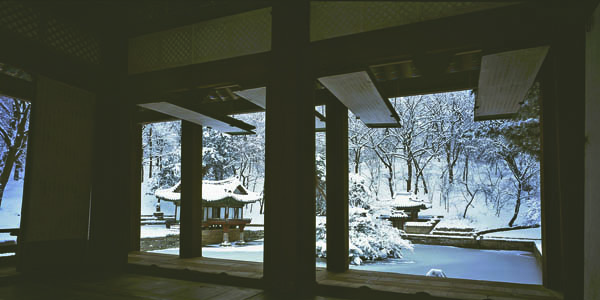Images old and new explore architecture

1. The 18th-century artist Kim Yoon-gyeom’s painting depicts Haein Temple (Haeinsa) surrounded by mountains, viewed from the opposite mountain. 2. Photographer Joo Myung-duck captures the solemn magnificence of the temple with a focus on Panjeon Hall, which houses the Tripitaka Koreana. 3. The findings on the arrangement of Haein Temple buildings are visualized through a three-dimensional model by Prof. Jeon Bong-hee and the Architectural History Lab of Seoul National University.[LEEUM, SAMSUNG MUSEUM OF ART]
This is part of the new knowledge visitors can learn from an exhibition about the old and familiar architecture of Korea, which starts today at the Leeum, Samsung Museum of Art in central Seoul.
The exhibition, titled “A Homage to Korean Architecture: Wisdom of the Earth,” also help the viewers feel the fresh beauty of old Korean architecture through works by six famous contemporary Korean photographers: Joo Myeong-duck, Bae Bien-u, Koo Bohn-chang, Kim Jae-gyeong, Seo Heun-kang, and Kim Do-kyun.
“The exhibition started from the Samsung Foundation of Culture’s project to publish a photographic collection of Korean architecture,” said Lee Joon, deputy director of the museum, at a press preview on Monday.

The painting by 18th-century master Kim Hong-do depicts a view of Gyujanggak Royal Library, built in the inner gardens of Changdeok Palace. [LEEUM, SAMSUNG MUSEUM OF ART]
With all these artworks, artifacts and new models, the museum intends to “shed new light on wisdom in utilizing the land and the relationship between architecture and location,” he said.
“The principal difference between Western architecture and Korean architecture lies in interpretation of the site and the handling of nature,” he added.

Bae Bien-u’s photograph captures the view of the pond in front of the library. [LEEUM, SAMSUNG MUSEUM OF ART]
In the exhibition, the research on the arrangement of Haein and Bulguk temples is visualized through 3-D models by Prof. Jeon Bong-hee and the Architectural History Lab of Seoul National University.
At the same time, Joo’s photos of Haein Temple shows the solemn and spiritual beauty of the temple. And the 18th-century artist Kim Yoon-gyeom’s painting that depicts Haein Temple surrounded by mountains, viewed from the opposite mountain, helps illustrate the history and evolution of Korean architecture.
Part I of the exhibition focuses on religious buildings including Buddhist temples and Jongmyo, the royal shrine of the Joseon Dynasty (1392-1910).
And Part II features paintings and photographs of royal palaces, city walls and government office buildings. The highlights of the section include the 6-meter-wide “Donggwoldo,” or “Painting of the Eastern Palace.” and “Sukcheon Jeado,” or “Illustrations of My Places of Work,” produced by a 19th-century scholar-official Han Pil-gyo. It is the first time the book, preserved at the Harvard-Yenching Library, is on display in Korea.
BY MOON SO-YOUNG [symoon@joongang.co.kr]
The exhibition runs through Feb. 6. Admission is 5,000 won ($4.30) for adults. Admission for elementary, middle and high school students is free on weekdays. The museum is closed on Mondays. For details, visit www.leeum.org or call (02) 2014-6901.










with the Korea JoongAng Daily
To write comments, please log in to one of the accounts.
Standards Board Policy (0/250자)